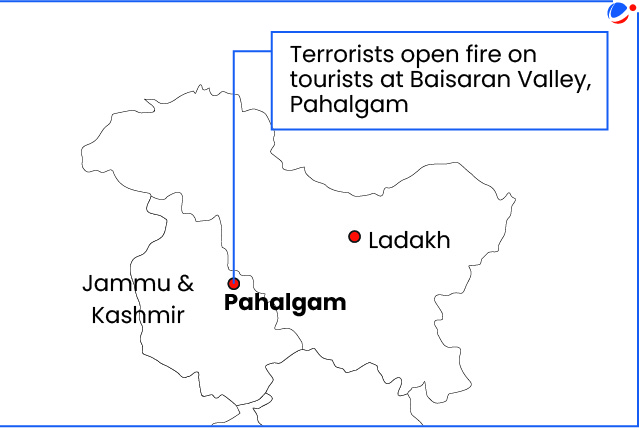
Why in the News?
The Resistance Front (TRF), an offshoot of the Pakistan-based terrorist organization Lashkar-e-Taiba (LeT), killed 26 tourists in Baisaran Valley in Pahalgam, Jammu and Kashmir.
More on the News
- In Response, India took several measures: e.g. suspending Indus Waters Treaty, Closing the Integrated Check Post at Attari, Scrapping the SAARC Visa Exemption Scheme for Pakistani nationals, suspending visa services for Pakistani nationals etc.
- India also launched precise airstrikes at 9 locations inside Pakistan and Pakistan Occupied Jammu and Kashmir (POJK) under 'Operation Sindoor'.
- These strikes have targeted strongholds of various terrorist organizations like LeT, Jaish-e-Mohammed (JeM) and other non-state actors which act as proxy of Pakistan to carry out terrorist activities in Jammu and Kashmir and other parts of India.

Recent Trends in Kashmir Terrorism:
- As per Ministry of Home Affairs' Annual Report of 2023-24, there has been a continuous decline in terrorist and militant attacks in the Union Territory (UT) of Jammu and Kashmir since 2019.
- Also, the economic activities related to tourism and other infrastructure development has been on rise, taking the UT towards political stability and economic prosperity.
- Experts believe that these recent attacks were carried out to derail the development journey of Jammu and Kashmir and create communal disharmony in other parts of India as well.
Factors behind terrorism in Jammu and Kashmir
- External Factors:
- Pakistan's ProxyWar: Pakistan state agencies provide training, arms, safe havens, and logistical support to groups like Lashkar-e-Taiba (LeT), Jaish-e-Mohammed (JeM), Hizbul Mujahideen (HM) and The Resistance Front (TRF).
- Pakistan uses these proxies as part of its 'hybrid war' against India as it finds difficult to defeat India in a direct military-to-military confrontation.
- International Non-Consensus: Inconsistent international pressure allows Pakistan to sustain proxy warfare without significant punitive measures. For e.g., China often uses Veto to protect Pakistan based non-state actors (like Masood Azhar) from being listed as terrorists in UNSC.
- Global Ideological Influence: Radical Islamist ideologies (e.g., ISIS), spread through transnational networks and ties between LeT and groups like Hamas, fuel radicalization.
- Porous borders facilitating infiltration: Challenging terrain along the LoC and international borders makes it difficult to completely seal the border, allowing for movement of militants and weapons.
- Pakistan's ProxyWar: Pakistan state agencies provide training, arms, safe havens, and logistical support to groups like Lashkar-e-Taiba (LeT), Jaish-e-Mohammed (JeM), Hizbul Mujahideen (HM) and The Resistance Front (TRF).
- Internal Factors:
- Radicalization: Online platforms (e.g., Telegram, YouTube) and local networks radicalize youth; these youth are later recruited by terrorist organizations.
- Political Alienation: Historical grievances, including use of Armed Forces Special Powers Act (AFSPA) of 1958, perceived lack of political representation, etc. deepen separatist sentiments.
- Economic Challenges: High unemployment and limited opportunities make youth vulnerable to recruitment by terror groups.
- Over Ground Workers (OGWs): OGWs play significant role in sustaining militancy through fund management, recruitment, propaganda and misinformation, etc.
- Terror Finance: E.g. separatist political outfits in Kashmir such as Hurriyat Conference, Duktaran-e-Milat, and Jammu Kashmir Liberation Front (JKLF) have channelized Hawala money from Pakistan to encourage local militancy.
Challenges in tackling terrorism in Jammu and Kashmir
- Hybrid Terrorist and Virtual Terrorist Outfits: Unlike traditional terrorists who are formally affiliated with terrorist organizations, hybrid terrorists are often unlisted, loosely connected, or self-radicalized individuals who carry out acts of terrorism while maintaining a low profile in society.
- In addition, security forces have noted proliferation of virtual terrorist groups like Jammu Kashmir Ghaznavi Force and TRF, which are nothing but front organisations for LeT and other terrorist outfits.
- Porous Borders: The Line of Control (LoC) in Jammu and Kashmir, due to its difficult terrain, enables infiltration and the smuggling of arms and personnel.
- Pakistan's information warfare: E.g. Use of social media platforms to stir anti-India propaganda.
- Intelligence Gaps: Fragmented coordination among central, state, and local agencies undermines timely responses.
- Evolving Technology: Terrorists use drones, encrypted apps, AI-generated propaganda, and advanced weaponry (often diverted from conflict zones like Afghanistan), complicating detection and response.
- Changing Tactics: Terrorists have shifted from large-scale attacks to targeted killings and attacks on soft targets like tourists and minorities.
Initiatives Taken to tackle terrorism in Jammu and Kashmir: | |
Crackdown on Terrorist Groups and their Ecosystem |
|
Tackling Cross-Border Militant Infiltration |
|
Developmental Steps |
|
Political |
|
Diplomatic |
|
Way Ahead
- Strengthen Intelligence: Enhance inter-agency coordination and invest in AI-driven analytics to counter cyber-radicalization, drone threats, illicit financing and OGWs.
- Develop strategies to reinforce HUMINT (Human Intelligence) to complement TECHINT (Technological Intelligence).
- Border Security: Faster implementation of installing smart fencing, thermal imaging, and surveillance along the LoC (As per recommendations of Madhukar Gupta Committee) to curb infiltration and smuggling.
- Improving inter-agency coordination between the Army, CRPF, Border Security Force, and JK Police is crucial.
- De-radicalization Programs: Scale up localized initiatives (e.g., education, sports, cultural integration) to counter extremist narratives and reduce youth vulnerability.
- Also, trust-building with local communities by winning of hearts and minds in terrorism-affected areas (e.g., Operation Sadbhavana) to disrupt OGWs networks with the help of local intelligence.
- Economic Development: Prioritize job creation, infrastructure, and tourism promotion to address economic grievances and foster stability.
- Political Process: Ensure inclusive governance to address political alienation and restore democratic trust through conducting of free and fair elections.
- International Pressure: India should utilize international platforms like UNSC (e.g., highlighting role of Pakistan in cross-border terrorism), FATF and take support of like-minded countries (e.g., Saudi Arabia and UAE) to put pressure on Pakistan to curb non-state actors operating from its soil.



